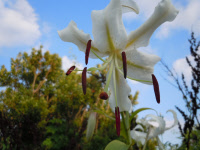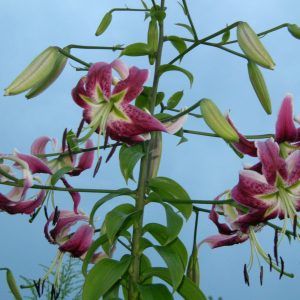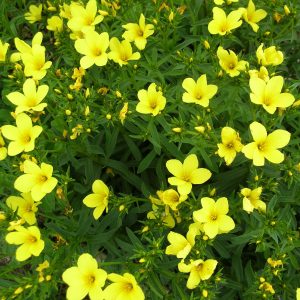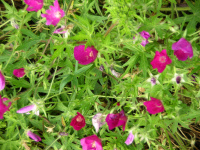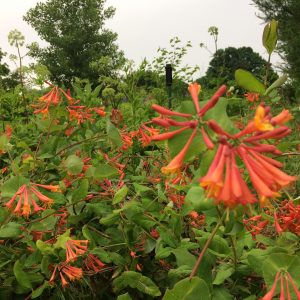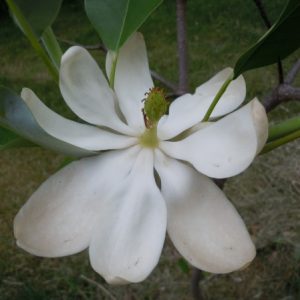Archives
Showing 113–120 of 199 results
-
Lilium speciosum album Showy lily Z 4-9
Large, nodding flower heads with recurved petals white, glowing pinkish in August, fragrant.
ARCHIVED
Note: This is a plant not currently for sale. This is an archive page preserved for informational use.
Large, nodding flower heads with recurved petals white, glowing pinkish in August, fragrant.
Size: 3-4’ x 12”
Care: Sun to part shade in moist, acidic soilLilium was named for the Greek word for smooth, polished referring to its leaves. This species introduced to Europe by Carl Peter von Thunberg around 1777. Von Thunberg (1743-1828), student of Linnaeus at Uppsala University in Sweden. He made three trips to the Cape of Good Hope 1772-1775 where he collected about 1000 new species, Java and Ceylon (Sri Lanka) 1777 and 15 months in Japan (1775-1777) where he befriended local doctors who gave him hundreds of plants new to Western horticulture. He succeeded Linnaeus as professor of medicine and botany at Uppsala. Knighted by Swedish King Gustav. Grown at America’s 1st botanic garden, Elgin Botanic Garden 1811. L.H. Bailey (1935) highly recommended this lily as “(o)ne of the most beautiful and satisfactory of all lilies, robust, permanent (and) easily grown…”
-
Lilium speciosum rubrum Z 4-9
Fragrant, deep pink spotted blossoms with recurved petals in late summer
ARCHIVED
Note: This is a plant not currently for sale. This is an archive page preserved for informational use.
Fragrant, deep pink spotted blossoms with recurved petals in late summer
Size: 3-4’ x 12”
Care: Sun to part shade in moist, acidic soil
Native: part of China & southern JapanLilium was named for the Greek word for smooth, polished referring to its leaves. Englebert Kaempfer, first physician to the Dutch East India Co. on Deschema Island (1690’s) described Lilium speciosum in his writings, published in 1712. Introduced to Europe by Siebold and to England in 1832. The English periodical Botanical Register described it: “surely if there is anything, not human, which is magnificent in beauty, it is this plant.” In 1896 the Wisconsin Horticultural Society praised this lily as deserving “…a prominent place in every garden…an old standard lily, as far back as our memory goes.”
-
Linum flavum compactum Dwarf golden flax Z 4-9 SUBSHRUB
Flowers like canary yellow cups, June-July.
ARCHIVED
Note: This is a plant not currently for sale. This is an archive page preserved for informational use.
Flowers like canary yellow cups, June-July.
Size: 6- 12”x 14”
Care: sun in well-drained to moist well-drained soil
Native: Central & So. EuropeDescribed by Parkinson in 1640. “Flowers golden yellow, in a much branching cyme, the showy petals much exceeding the …sepals … not popularly known in this country.” L H Bailey (1933)
-
Liquidambar styrociflua Sweet gum Z 5-9
Star-shaped leaves turn parti-color in fall – red, purple, orange. Gum ball fruit matures in winter.
ARCHIVED
Note: This is a plant not currently for sale. This is an archive page preserved for informational use.
Star-shaped leaves turn parti-color in fall – red, purple, orange. Gum ball fruit matures in winter.
Size: 60-80‘ x 40-60’
Care: sun in moist to moist well-drained acidic soil
Native: Eastern US north to southern IL & west to Mississippi River.
Wildlife Value: Deer resistant & black walnut tolerant. Seeds food for numerous birds.Cherokee made a salve for wounds & sores from the tree & mixed it with sheep or cow tallow for itches.
Collected before 1753. Grown at America’s 1st botanic garden, Elgin Botanic Garden 1811.**LISTED AS OUT OF STOCK BECAUSE WE DO NOT SHIP THIS ITEM. IT IS AVAILABLE FOR PURCHASE AT OUR RETAIL LOCATION.
-
Long blooming Garden for sun
Long Blooming Garden for sun.
ARCHIVED
Note: This collection is not currently for sale. This is an archive page preserved for informational use.
Long Blooming Garden for Sun Size : Height x width* Bloom color
3 Agastache foeniculum -Anise hyssop 2-3’ x 12” purple
1 Callirhoe involucrata – Prairie poppy mallow 6” x 12-24” magenta
3 Erodium manescavii – Heron’s bill 12-18” x 8” magenta
1 Papaver rupifragum – Spanish poppy 12-18” x 8” purple
3 Rudbeckia triloba – Brown-eyed susan 3-4’ x 2-3’ yellow
3 Ruellia humilis – Prairie petunia 8-10” x 10” purple
1 Scabiosa ochroleuca- Cream pincushion flower 24-30” x 18” white
1 Teucrium hircanicum – Iranian germander 18” x 28” purpleThese BLOOM for two months or more. All plants are perennials.
If planted together in one garden these make a 24 square foot garden. *Most of these plants get wider over time by spreading roots or by self-seeding . -
Lonicera x brownii ‘Dropmore Scarlet’ Dropmore Scarlet trumpet honeysuckle Z 2-8
Clusters of scarlet trumpets with orange throats repeat bloom July into fall.
ARCHIVED
Note: This is a plant not currently for sale. This is an archive page preserved for informational use.
Clusters of scarlet trumpets with orange throats bloom repeatedly from July into fall.
Size: 10-12’ x 2-3’ fast growing
Care: sun to part shade in moist well-drained soil. Prune in early spring
Wildlife Value: Hummingbirds love the red trumpet-shaped flowers. Tolerates walnut toxicity.Cross of L. sempervirens and L. hirsuta. This long-blooming selection made by Dr. F.L. Skinner at Dropmore Manitoba. Introduced in 1950.
-
Magnolia virginiana Sweetbay magnolia 5-10
Large, ivory cups, lemon scented
ARCHIVED
Note: This is a plant not currently for sale. This is an archive page preserved for informational use.
Large, ivory cups, lemon scented, in May & June & sporadically all summer & fall. 6” long leaves, waxy green on top and silvery-frosted beneath. In fall fruits open to reveal bright red seeds.
Size: 20’ x 15’
Care: Sun to part shade in acidic, moist to moist well-drained soil
Native: Atlantic coast from NY to FL, west along Gulf coast to TX
Wildlife Value: nectar source for Spicebush swallowtail butterflyMagnolia named for Pierre Magnol, Montpellier professor of medicine and director of the botanic garden. (1638-1715) This species collected by Rev. John Banister in Virginia c. 1690. One of the mainstays of John Bartram’s seed business, Peter Collinson, Bartram’s agent in England, said, “the name Magnolia will sell a box of seeds.” Offered for sale in Bartram Garden’s 1783 Broadside, America’s 1st plant catalog. Pressed specimen in Emily Dickinson’s herbarium.
-
Marshallia caespitosa Barbara’s Buttons Z 5-8
Dainty balls of white, fragrant flowers are borne on slender, leafless stalks, April to June
ARCHIVED
Note: This is a plant not currently for sale. This is an archive page preserved for informational use.
Dainty balls of white, fragrant flowers are borne on slender, leafless stalks, April to June
Size: 12-18” x 6-12”
Care: full sun to part shade in moist, well-drained soil
Native: KS to AR, LA & TX
Wildlife Value: Attracts bees and butterfliesMarshallia grows wild in prairies with Little bluestem and Coreopsis lanceolata. Nuttall, 1836
Genus name honors Humphry Marshall (1722-1801) and his nephew Moses Marshall (1758-1813), American botanists.

